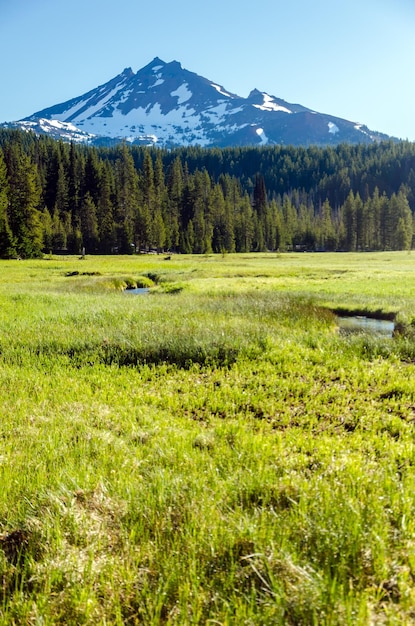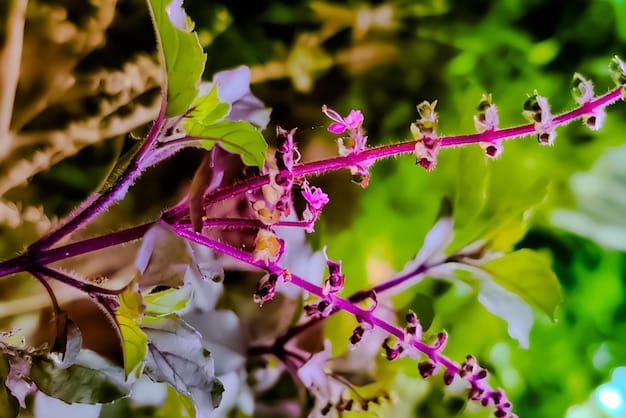US National Park Preservation: Combating Invasive Species for Biodiversity

US National Park Preservation faces ongoing challenges from invasive species, prompting the implementation of innovative strategies such as advanced monitoring technologies, biological controls, and collaborative conservation efforts to protect native biodiversity and ecosystem health.
Preserving the natural beauty and ecological integrity of the United States’ national parks requires constant vigilance and innovative strategies, especially when it comes to combating invasive species and protecting biodiversity. These efforts are crucial to maintaining the health and resilience of these iconic landscapes for future generations.
Understanding the Threat of Invasive Species
Invasive species pose a significant threat to the ecological balance of US National Parks. Understanding the nature of this threat is crucial for developing effective preservation strategies. This includes identifying the types of invasive species, their impacts, and the factors that contribute to their spread.
What are Invasive Species?
Invasive species are non-native organisms that cause harm to the environment, economy, or human health. They often lack natural predators or diseases in their new environment, allowing them to proliferate and outcompete native species.
Impact on National Parks
The spread of invasive species can lead to habitat degradation, loss of biodiversity, and disruption of ecosystem functions. This can have cascading effects on entire food webs and the overall health of the park’s natural resources.
- Habitat destruction: Invasive plants can alter vegetation structure and composition, impacting wildlife habitats.
- Competition with native species: Invasive animals can compete with native species for food, water, and shelter.
- Disease transmission: Invasive species can introduce new diseases and parasites that threaten native populations.
Effective US National Park Preservation requires ongoing monitoring, research, and management efforts to mitigate the impacts of invasive species and protect native biodiversity.

Innovative Monitoring Technologies
Effective monitoring is essential for early detection and rapid response to invasive species threats. Advancements in technology have enabled park managers to enhance their monitoring capabilities and improve the efficiency of their control efforts. These tools provide valuable data for informed decision-making and adaptive management.
Remote Sensing
Remote sensing technologies, such as satellite imagery and drone surveillance, can be used to detect and map invasive species over large areas. This allows park managers to identify new infestations and track the spread of existing populations more efficiently.
Environmental DNA (eDNA)
eDNA analysis involves collecting and analyzing DNA from environmental samples, such as water or soil, to detect the presence of specific species. This technique can be used to identify invasive species even when they are rare or difficult to detect through traditional methods.
- Early detection: eDNA can detect invasive species before they become widespread.
- Non-invasive: eDNA sampling is less disruptive than traditional survey methods.
- Cost-effective: eDNA analysis can be more efficient than traditional monitoring techniques.
By leveraging these innovative monitoring technologies, park managers can improve their ability to detect and respond to invasive species threats, ultimately contributing to the long-term US National Park Preservation.
Biological Control Strategies
Biological control involves the use of natural enemies, such as insects, pathogens, or herbivores, to control invasive species populations. This approach can provide a sustainable and environmentally friendly alternative to traditional chemical control methods. However, careful research and risk assessment are essential to ensure that biological control agents do not pose unintended consequences for native ecosystems.
Classical Biological Control
Classical biological control involves introducing natural enemies from the invasive species’ native range to control its populations in the new environment. This approach has been successful in controlling a variety of invasive plants and insects in US National Parks.
Natural enemies can reduce the invasives’ vigor, reproduction, or spread, allowing native species to recover and regenerate.
Augmentative Biological Control
Augmentative biological control involves releasing additional numbers of natural enemies to supplement existing populations. This approach can be used to provide short-term control of invasive species infestations during critical periods.
Release of lab-reared predators, parasites, or pathogens can bolster the effectiveness in suppressing invasives.

Biological control strategies offer a promising approach for long-term US National Park Preservation, but require careful planning, monitoring, and adaptive management to ensure their effectiveness and safety.
Collaborative Conservation Efforts
Addressing the challenges posed by invasive species requires a collaborative approach involving multiple stakeholders, including federal and state agencies, local communities, non-profit organizations, and private landowners. By working together, these groups can pool resources, share expertise, and implement coordinated management strategies across jurisdictional boundaries.
Partnerships
Partnerships between US National Parks and other organizations can enhance the effectiveness of invasive species management efforts. These partnerships can provide access to additional funding, technical expertise, and volunteer support.
These collaborations allow for shared responsibility and integrated approaches to tackle invasive threats across broader landscapes.
Citizen Science
Citizen science programs engage members of the public in data collection and monitoring efforts. This can significantly expand the capacity of park managers to monitor invasive species populations and track their spread. Such initiatives also foster environmental stewardship among participants who assist in preserving natural resources.
- Increased monitoring capacity: Citizen scientists can help monitor large areas more efficiently.
- Public awareness: Citizen science programs raise awareness about invasive species issues.
- Data collection: Volunteers can gather valuable data on species distribution and abundance.
Collaborative conservation efforts are essential for achieving long-term US National Park Preservation and protecting biodiversity in the face of invasive species threats.
Restoration and Rehabilitation
In addition to controlling invasive species, it is important to restore and rehabilitate degraded ecosystems to promote the recovery of native plant and animal communities. This can involve a variety of techniques, such as revegetation, soil stabilization, and habitat enhancement.
Revegetation
Revegetation involves planting native plant species to restore degraded areas and create habitat for wildlife. This can help to outcompete invasive plants and promote the recovery of native ecosystems.
Native plants are suited for the local climate and soil conditions, assisting with the resilience of the park.
Soil Stabilization
Soil stabilization techniques can be used to prevent erosion and promote the establishment of native vegetation. This can involve mulching, seeding, and the use of erosion control fabrics.
- Erosion control: Stabilizing soil prevents further degradation of the habitat.
- Nutrient cycling: Healthy soils support the growth of native plants and promote ecosystem recovery.
- Water infiltration: Stabilized soils improve water infiltration and reduce runoff.
Restoration and rehabilitation efforts are crucial for ensuring the long-term health and resilience of US National Park Preservation and the preservation of biodiversity.
Policy and Legislation
Effective policy and legislation are essential for preventing the introduction and spread of invasive species in US National Parks. This includes regulations on the importation of non-native species, as well as laws that authorize and fund invasive species management programs. Strong interagency coordination is also needed to address these challenges effectively.
Federal Regulations
Federal regulations, such as the Lacey Act and the Plant Protection Act, provide a framework for preventing the introduction and spread of invasive species across state and national borders. These laws prohibit the importation and interstate transport of certain invasive species and authorize federal agencies to take action to control or eradicate them.
State Laws
Many states have their own laws and regulations pertaining to invasive species management. These laws can complement federal regulations and provide additional tools for preventing and controlling invasive species within state boundaries.
- Prevention: Preventing the introduction of new invasive species is critical.
- Early detection and rapid response: Rapidly addressing new infestations can prevent them from becoming widespread.
- Control and eradication: Controlling or eradicating existing invasive species populations is essential for protecting native ecosystems.
Key Point
Brief Description
🌱 Prevention Strategies
Implementing measures to prevent the introduction of new invasive species.
🔬 Monitoring Technologies
Using advanced tech for early detection and mapping of invasive species.
🤝 Collaborative Efforts
Establishing partnerships and citizen science programs for broad support.
🌿 Restoration Initiatives
Implementing strategies to rehab degraded ecosystems with native species.
Frequently Asked Questions
▼
Invasive species, habitat loss, climate change, and pollution are key factors impacting biodiversity in national parks.
▼
Parks employ remote sensing, eDNA analysis, and GPS tracking to efficiently detect and track invasive species.
▼
Partnerships between governmental agencies, non-profits, and citizen science initiatives improve park conservation.
▼
Biological control introduces natural enemies like insects to control invasive plants. It’s a long term method.
▼
Restoring deteriorated habitats supports the recovery of native plants, enhancing entire ecosystems.
Conclusion
Protecting US National Park Preservation requires the combined effort of strategic planning, technological advancements, and community support. By continuously adapting and innovating, it is possible to mitigate the harmful effects of invasive species. The commitment to conservation ensures that these treasured landscapes continue to thrive.





